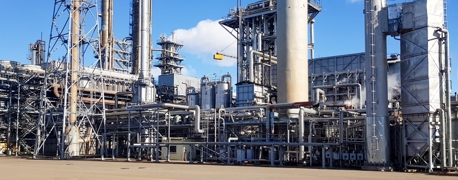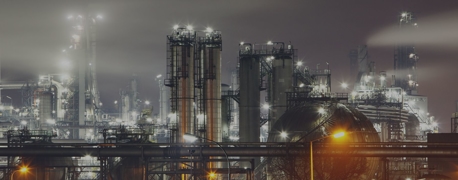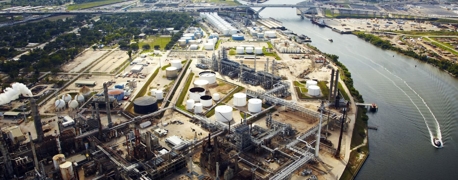The 10 Biggest Power Plants in the U.S.

Located across the country, power plants play a critical role in supplying electricity to all Americans. These industrial facilities generate electricity through various means, typically using generators that convert mechanical energy into electrical energy.
Mechanical energy, which is defined as the sum of kinetic energy (created by motion) and potential energy (created by position or electric charge), can be created in a power plant using a primary fuel (such as coal, natural gas, or uranium) or a primary energy flow (such as water or wind).
There are two main types of power plants: thermal and renewable.
Most thermal power plants use a primary fuel to turn water into highly pressurized steam, which is used to rotate the blades of a turbine. The spinning turbine turns massive wire coils inside a generator, which converts the kinetic energy into electric energy. Coal-fired power plants, natural gas power plants, and nuclear power plants are all thermal power plants.
Renewable power plants utilize primary energy flows to generate electricity. They are renewable because their energy sources replenish themselves, but this also means they may be limited in the amount of energy they can utilize at any given time. Their productivity may also be intermittent. Hydroelectric facilities use the power of falling water, wind turbines use the power of wind, and solar panels use the power of the sun to produce energy that can be converted into electricity.
Most of the top-producing power plants in the United States are thermal; the majority of these utilize nuclear power to create pressurized steam that can be converted into electricity.
According to the Energy Information Administration (EIA), the 10 biggest power plants in the U.S., measured by annual net energy generation, are:
1. Palo Verde (Nuclear) in Arizona
The Palo Verde Generating Station has held the status of the largest energy producer in the United States for nearly three decades. Construction on the plant first began in 1976 and was completed in 1988; it cost $5.9 billion in 1986 USD to build, which is equivalent to approximately $12.1 billion today. Palo Verde is located on 4,000 acres of land in the desert near Tonopah, Arizona, about 45 miles west of Phoenix. It is the only large nuclear power plant that is not located near a body of water; it uses treated sewage from nearby cities and towns to cool the steam it produces. Each year, Palo Verde evaporates up to 26 billion gallons of treated water.
Palo Verde has three pressurized water reactors. Each reactor can produce 1.4 gigawatts of power, but they typically produce at about 70% to 90% capacity. In 2020, the Palo Verde Generating Station produced more than 31.5 million megawatt hours (MWh) of electrical energy. The plant employs more than 2,000 full-time workers.
2. Browns Ferry (Nuclear) in Alabama
The Browns Ferry Nuclear Plant is located on 840 acres on the Tennessee River near Decatur, Alabama. It utilizes three boiling water reactors, which were built from 1967 to 1977. When it first went into commission, Browns Ferry was the largest nuclear plant in the world. Today, it is the second-highest producer in the United States. In 2020, the plant produced more than 28.7 million MWh of electricity. Browns Ferry employs 1,500 workers.
3. South Texas Project (Nuclear) in Texas
The South Texas Project (STP) is a nuclear power plant located on a 12,200-acre site on the west bank of the Colorado River approximately 90 miles from Houston, Texas. The plant utilizes two pressurized water reactors and has a 7,000-acre reservoir to meet its cooling needs. Construction on the South Texas Project plant began in 1975 and was completed in 1989. In 2020, the plant generated more than 21.9 MWh of electrical power.
4. Peach Bottom (Nuclear) in Pennsylvania
The Peach Bottom Atomic Power Station is located on the Susquehanna River in York County, Pennsylvania, about 50 miles southeast of Harrisburg. Peach Bottom Unit 1, which was completed in 1967 and decommissioned in 1974, was an experimental helium-cooled reactor. Units 2 and 3, which became operational in 1974, are boiling water reactors and are still in use today. In 2020, Peach Bottom produced nearly 21.8 MWh of electricity, making it the fourth largest energy producer in the country.
5. Oconee (Nuclear) in South Carolina
The Oconee Nuclear Station is located on Lake Keowee near Seneca, South Carolina. Construction first began on the nuclear power plant in 1967; it was completed and in commission in 1974. It has three pressurized water reactors, and in 2011, it became the first nuclear plant in the U.S. to have digitally controlled sensors. The Oconee Nuclear Station is also unique in that it does not rely on diesel generators for emergency power. Instead, its backup system utilizes two hydroelectric units at the Keowee hydroelectric station. In 2021, Oconee produced more than 21.5 MWh of electrical energy.
6. Braidwood Generating Station (Nuclear) in Illinois
Braidwood Generating Station is a nuclear power plant located on a 4,457-acre site in Will County, Illinois that has been in operation since 1988. The station utilizes two pressurized water reactors and can produce enough electricity to power two million homes. In 2020, Braidwood generated over 20.3 million MWh of energy.
7. Grand Coulee (Hydroelectric) in Washington
The Grand Coulee Dam was built between 1933 and 1942 on the Columbia River in Washington. It is 550 feet tall and 5,223 feet wide, with a 500-foot-wide base and a 30-foot-wide crest. There are 4 power houses at the Grand Coulee Dam, containing a total of 33 hydroelectric generators. The Grand Coulee is the biggest power plant in the United States in terms of capacity – or what it can produce, but its actual output is generally lower. As a hydroelectric facility, it is more affected by external factors like weather and droughts than nuclear plants. In 2020, the Grand Coulee produced nearly 20.3 million MWh of energy.
8. Susquehanna Steam Electric Station (Nuclear) in Pennsylvania
The Susquehanna Steam Electric Station is located on the Susquehanna River in Salem Township, Pennsylvania. Construction on the nuclear power plant began in 1973; the facility’s two boiling water reactors were fully operational in 1985. The Susquehanna Steam Electric Station sits on a 1,075-acre site and employs more than 1,100 workers. In 2020, the plant produced 19.99 MWh of electrical energy.
9. West County Energy Center (Natural Gas) in Florida
West County Energy Center is the only natural gas power plant on our list of the biggest plants in America. It sits on 220 acres in Palm Beach County, Florida, and has 3 gas turbine generating units that are capable of producing 1,250 megawatts of power each. It is also one of the youngest plants on the list. It has been operational since 2009 and is the largest natural gas power plant in the country. In 2020, West County Energy Center produced 19.76 MWh of energy.
10. LaSalle County Generating Station (Nuclear) in Illinois
The LaSalle County Nuclear Generating Station is located in Brookfield Township, Illinois, about 11 miles southeast of Ottawa. Construction on the plant first began in 1973, and both of its boiling water reactors were operational in 1984. In 2020, the LaSalle County Generating Station produced nearly 19.7 MWh of electrical energy.
Why Are There So Many Nuclear Power Plants on the List?
Of all U.S. power plants, those that rely on nuclear energy have consistently produced the most electricity every year for the past several decades. Since 1990, nuclear energy has been the source of about one-fifth of the country’s power, primarily because of its reliability.
While the Grand Coulee Dam may have a higher Nameplate capacity (which is a measure of the maximum power it can produce when the plant is running perfectly and at full capacity) than any other power plant in the United States, it ranked 7th on the list of top-10 power plants in the country. This is because it, like other renewable power plants, cannot produce at maximum capacity 100% of the time.
According to the U.S. Department of Energy, nuclear power plants produce at maximum power more than 92% of the time. That’s almost twice as much as natural gas and coal power plants and three or more times as much as wind and solar plants. Hydropower plants, such as the Grand Coulee Dam, operate at maximum capacity just 41.5% of the time, on average.
Why are nuclear power plants more reliable? Because they require less maintenance and can operate for longer periods of time before refueling. Routine maintenance and refueling at fossil fuel plants limit their operations more often, and renewable energy sources like wind or water are intermittent and variable, affected by factors like weather or droughts.
Is It Dangerous to Live Near a Power Plant?
According to an EPA article titled Power Plants and Neighboring Communities, fossil fuel power plant emissions contribute to the formation of ground-level ozone and particulate matter. These emissions have been linked to various respiratory and cardiovascular issues, increased cancer risks, and immune system problems.
Nuclear power plants present risks of environmental contamination as well, with the added risk of an accident that could put everyone within a 10-mile radius at risk of exposure to high concentrations of radioactive material. Exposure to radioactive substances can cause DNA damage and cancer, as well as symptoms such as nausea, hair loss, and vomiting. Acute exposure can damage the central nervous system and may be fatal.
The hazards of power plant emissions are widely known and have been reduced dramatically over the past decades, thanks to strict policies and procedures regarding their operations. To operate in the United States, a power plant must be properly licensed. It can only get this license if it is in full compliance with regulations pertaining to plant security and the protection of the environment and public safety. These measures go so far as to consider the chances of seismic activity in the area and whether this could damage any part of the facility. Power plant licenses are also limited, which means they must be renewed every 20 years.
For nuclear power plants, the Nuclear Regulatory Commission (NRC) is responsible for enforcing these measures, and it does so by not only maintaining oversight of power plant construction but also ongoing operations – throughout the entire lifetime of the facility.
Today, living near a power plant will always present a risk of exposure to its emissions, but these should be minimized if the plant complies with federal standards.
How Often Do Power Plant Accidents Happen?
The real risk of living near or working at a power plant comes when safety procedures are not followed to the letter. The last major nuclear power plant incident in the U.S. occurred on March 28, 1979, in Pennsylvania. Attributed to equipment failure and operator error, the incident involved a partial core meltdown of a pressurized water reactor at Three Mile Island, a nuclear power plant in Londonderry Township. The reactor was destroyed, and a small amount of radioactive gas was released. The cleanup effort started that August and finally ended in 1993, costing about $1 billion. Opinions regarding the long-term health effects of the Three Mile Island incident are varied, but the consensus is that they were minimal. Workers inside the plant, however, were exposed to dangerous levels of radiation.
What We Can Do
Regardless of the risks they present, we rely on power plants to supply our electricity. This is unlikely to change anytime within the next several decades. That is why plant owners and operators must be held to the highest standard regarding worker safety and environmental regulations.
At Arnold & Itkin, we represent industrial workers, property owners, business owners, and people all across the U.S. who have been adversely affected by corporations who put profits above safety. We have represented survivors of plant and refinery accidents, families who have lost loved ones in pipeline explosions, and workers on land and offshore who have been exposed to the worst disasters. We have won more than $20 billion for the injured and wronged, and we will continue to fight every day for improved safety for workers and communities. No matter what.


